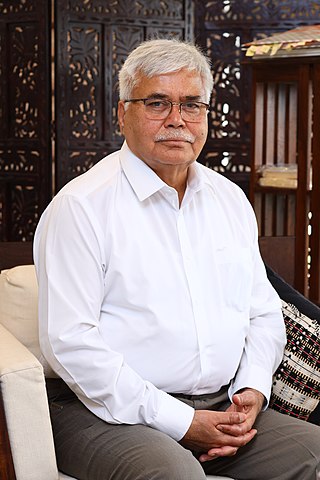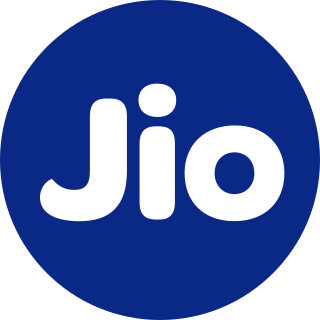India's telecommunication network is the second largest in the world by number of telephone users with 1179.49 million subscribers as on 31 January 2021. It has one of the lowest call tariffs in the world enabled by mega telecom operators and hyper-competition among them. India has the world's second-largest Internet user-base with 747.41 million broadband internet subscribers in the country.
Telecommunications in Pakistan describes the overall environment for the mobile telecommunications, telephone, and Internet markets in Pakistan.
A mobile virtual network operator (MVNO) is a wireless communications services provider that does not own the wireless network infrastructure over which it provides services to its customers. An MVNO enters into a business agreement with a mobile network operator to obtain bulk access to network services at wholesale rates, then sets retail prices independently. An MVNO may use its own customer service, billing support systems, marketing, and sales personnel, or it could employ the services of a mobile virtual network enabler (MVNE).

Bharti Airtel Limited, commonly known as (d/b/a) Airtel, is an Indian multinational telecommunications services company based in New Delhi. It operates in 18 countries across South Asia and Africa, as well as the Channel Islands. Currently, Airtel provides 4G and LTE Advanced services all over India and 5G service in selected cities. Currently offered services include fixed-line broadband, and voice services depending upon the country of operation. Airtel had also rolled out its Voice over LTE (VoLTE) technology across all Indian telecom circles. It is the largest mobile network operator in India and the second largest mobile network operator in the world. Airtel was named India's 2nd most valuable brand in the first ever Brandz ranking by Millward Brown and WPP plc.
Aircel Ltd. was an Indian mobile network operator headquartered in Mumbai that offered voice and 2G and 3G data services. Maxis Communications held a 74% stake and Sindya Securities and Investments held the remaining 26%. Aircel was founded by Chinnakannan Sivasankaran and commenced operations in Tamil Nadu in 1999. It was once a market leader in Tamil Nadu and had considerable presence in Odisha, Assam and North-East telecom circles. 2G and 3G Services including voice were shut down in all circles after failure of merger talks with Reliance Communications.

Telephone numbers in India are administered under the National Numbering Plan of 2003 by the Department of Telecommunications of the Government of India. The numbering plan was last updated in 2015. The country code "91" was assigned to India by the International Telecommunication Union in the 1960s.

Internet in India began in 1986 and was available only to the educational and research community. General public access to the internet began on 15 August 1995. American multinational digital communications technology conglomerate Cisco estimated that India will have more than 900 million internet users by 2023.

Ram Sewak Sharma is an Indian bureaucrat and former civil servant. From February 2021, he is serving as the Chief Executive Officer of the National Health Authority, an Indian governmental organisation tasked with managing public health insurance. Previously, he has headed the Telecom Regulatory Authority of India, and the Unique Identification Authority of India.
In telecommunications, the dropped-call rate (DCR) is the fraction of the telephone calls which, due to technical reasons, were cut off before the speaking parties had finished their conversational tone and before one of them had hung up. This fraction is usually measured as a percentage of all calls.
Direct-to-Home (DTH) television is a method of receiving satellite television by means of signals transmitted from direct-broadcast satellites. The Government of India (GoI) permitted the reception and distribution of satellite television signals in November 2000. The first DTH service in the country was launched by Dish TV on 2 October 2003. DD Free Dish, the first free DTH service in India, was launched by public broadcaster Prasar Bharati in December 2004.

The Telecommunications Regulatory Authority of Lebanon is an independent public institution established by Law 431/2002 and legally mandated to liberalize, regulate, and develop telecommunications in Lebanon. The TRA effectively started operations upon the nomination of its board members in February 2007.
The Telecom Commercial Communication Customer Preference Regulations, 2010 (TCCCPR) is a Regulation by Telecom Regulatory Authority of India, enacted in 2010, came into force from 27 September 2011. The regulation was launched by Telecom minister of India Kapil Sibal which enables people across India to respite from pesky marketing calls and SMS.
The Telecommunications Dispute Settlement and Appellate Tribunal (TDSAT) was established to adjudicate disputes and dispose of appeals with a view to protect the interests of service providers and consumers of the Indian telecommunications sector and to promote and ensure its orderly growth.
The National Customer Preference Register (NCPR), formerly the National Do Not Call Registry (NDNC), is intended to give Indian consumers an opportunity to limit the telemarketing calls they receive. The Telecom Regulatory Authority of India (TRAI) is the Indian governmental agency tasked with defining various policies and regulations for wireless communication service providers in India. As per TRAI regulation, every mobile service provider in India is required to set up a National Customer Preference Register (NCPR). In practice, various service providers refer to it as the Do Not Disturb (DND) registry. Telemarketers, after registration from TRAI, receive permission to access the NCPR.
The Advisor, TRAI is the head of different divisions in the Telecom Regulatory Authority of India (TRAI).The advisors are in the rank and pay of Joint Secretaries to Government of India. The advisors look into the ten functional divisions, namely Mobile Network, Interconnection & Fixed Network, BroadBand and Policy Analysis, Quality of Service, Broadcasting & Cable Services, Economic Regulation, Financial Analysis & IFA, Legal, Consumer Affairs & International Relation and RE & Administration & Personnel.Officers are selected from the premier Indian Administrative Service and Indian Revenue Service and also from the Indian Telecommunication Service as well as the Indian Economic Service.
Rahul Khullar was an IAS officer of the 1975 batch and a former Chairman of the Telecom Regulatory Authority of India (TRAI).
Mechanisms for establishing rules ensuring Net neutrality in India, are at present mainly enforced by the Telecom Regulatory Authority of India (TRAI). At present, there are no specific legislation regarding Net Neutrality in India.

Reliance Jio Infocomm Limited, doing business as Jio, is an Indian telecommunications company and a subsidiary of Jio Platforms, headquartered in Navi Mumbai, Maharashtra, India. It operates a national LTE network with coverage across all 22 telecom circles. Jio offers 4G and 4G+ services all over India and 5G service in many cities. Its 6G service is in the works.
Net neutrality is the principle that governments should mandate Internet service providers to treat all data on the Internet the same, and not discriminate or charge differently by user, content, website, platform, application, type of attached equipment, or method of communication. For instance, under these principles, internet service providers are unable to intentionally block, slow down or charge money for specific websites and online content.







